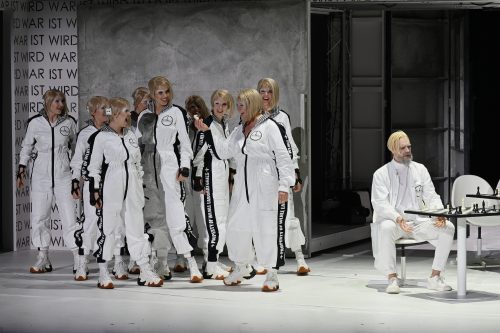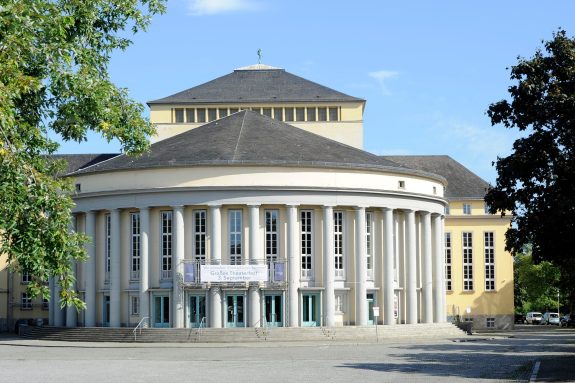 Germany Wagner, Die Walküre: Soloists, Chorus of Saarländisches Staatstheater. Saarländisches Staatsorchester / Stefan Neubert (conductor). Saarländisches Staatstheater, Saarbrücken, 29.6.2024. (DMD)
Germany Wagner, Die Walküre: Soloists, Chorus of Saarländisches Staatstheater. Saarländisches Staatsorchester / Stefan Neubert (conductor). Saarländisches Staatstheater, Saarbrücken, 29.6.2024. (DMD)

Production:
Direction, Stage and Costume design – Alexandra Szemerédy, Magdolna Parditka
Lighting design – Thomas Roscher
Video – Leonard Koch
Dramaturgy – Benjamin Wäntig
Cast:
Sieglinde – Ingegjerd Bagøien Moen
Siegmund – Peter Sonn
Hunding – Hiroshi Matsui
Wotan – Thomas Johannes Mayer
Brünnhilde – Aile Asszonyi
Fricka – Judith Braun
Gerhilde – Elizabeth Wiles
Ortlinde – Merit Nath-Göbl
Waltraute – Judith Braun
Schwertleite – Maria Polańska
Helmwige – Valda Wilson
Siegrune – Johanna Jaworowska
Grimgerde – Clara-Sophie Bertram
Rossweisse – Carmen Seibel
Freia – Elizabeth Wiles
Loge – Mario Ferber
The environment that the team jointly responsible for directing as well as stage and costume design – Alexandra Szemerédy and Magdolna Parditka – had created for the miniature universe of Die Walküre, was that of a laboratory. The company had a name and corresponding logo, WLLHLL, reminiscent of Valhalla (in the German spelling). Freia, and Loge (from Das Rheingold) were lab assistants, Hunding was a lab doctor, Fricka a lab nurse with managerial powers representing an ethics committee of some kind. The twins Siegmund and Sieglinde were the current main research subjects, the Valkyries were the results of former experiments. Wotan ruled supreme as the chief scientist of the lab. All creatures had blond hair that looked artificial, the lab workers wore white lab clothes, the subjects of their experiments wore training-suit-like outfits in black and white. It was all very clinical, equally mainly black and white, with the three words ‘wird / will be or will become)’, ‘war’ (was, has been), and ‘ist’ (is) arranged in the three possible sequences above and next to each other. There were many assumed and genuine entrance and exit options, some with sliding doors, some unnoticeable in the walls. The control room was located, and visible for some of the scenes, on a level above the main lab area where the experiments took place. Something was happening in this space throughout, monitors showed camera images of other areas, other screens represented monitors of life functions, other screens showed rotating 3D images of the brain, there was a DNA model in permanent slow spinning motion, and a modified model human skeleton.

It would take a long time to narrate the ways in which this directorial concept worked in detail, to analyse how more or less striking ideas emanating from the concept related to the plot, libretto and score. What was the significance, for example, of having Wotan’s control over the Valkyries represented by him operating a smart watch which apparently triggered a brain implant in the Valkyries? Or that Siegmund and Sieglinde were physically separated at first – they communicated only through their brains. Only later were the walls between their lab cells removed and they encountered each other in ‘person’. At the end, Brünnhilde’s genetic and brain information was extracted and stored, her body cremated. All the other Valkyries were released of their Valkyrie status, they had a brief moment of happy surprise before they collapsed (and ‘died’?)
There were thus many visual stimuli, most of which were clearly obvious as having been intended by the production team. For other aspects of the production it was not so clear whether they were intended or in fact indications that the facilities available to realise the concept were not quite up to the intentions: At times the sounds of the stage machinery moving part of the set interwove with, or even overshadowed the music; bulky parts of the set crashed into each other noisily, triggering brief but alarmed glances from the singers, who also needed to be careful unless a part of the walls they leant against was in fact a door that gave way to their weight. Some smaller walls, those that initially separated Sieglinde and Siegmund’s lab cells, were clearly wobbly.
As someone interested in science in general and science labs in particular, I was interested in whether it all ‘worked’ or not. I could imagine that someone not as familiar with the concepts at the core of the production may have found them puzzling, and their multitude both overwhelming and distracting from, rather than adding to, the music and singing. I saw some members of the audience sitting with their eyes closed. The music was at a very high level indeed. The performance was conducted by Stefan Neubert, the company’s long-serving First Kapellmeister. He brought out many subtle nuances of the score, emphasising the full potential of all the gentle and emotional material. The volume was held back for much of the evening, allowing the louder passages to come to the fore even more strikingly.
The singers were able to engage in the subtle aspects of their parts more easily and thus more fully, rather than having to pay too much attention to the volume of their voices in relation to the orchestra. Peter Sonn as Siegmund excelled in the lyrical nature of the music composed for Siegmund with a radiantly bright upper range, leaving sufficient strength for well-supported and engaging cries of ‘Wälse!’ He was particularly impressive in the second act. Ingegjerd Bagøien Moen sounded youthfully fresh as Sieglinde, with a strong upper register, while the lower range of the voice will benefit from further development. Hiroshi Matsui as Hunding was convincing with his very large, booming bass, which he struggled only occasionally to keep in focus.
The vastly experienced Thomas Johannes Mayer was an excellent Wotan: his bass-baritone was rich, his intonation precise. His musicality allowed him to sing rather than recite the long Act II narrations, and he and conductor Neubert celebrated the volume of Wotan’s Farewell, starting with a towering ‘Leb wohl’. The assistant director announced Aile Asszonyi’s indisposition at the beginning of the evening. There were only few uneasy moments of coughing and a few dropped high notes for Brünnhilde’s opening exclamations, but otherwise any indisposition went unnoticed: this was a very accomplished performance, most certainly among the best of her peers in this demanding role. Fricka was conceptualised as equally young and rather than as a more mature woman (as in most productions that follow the libretto more closely in this respect). Judith Braun brought out the musical arcs characteristic of this role very well indeed, with her rich and appropriately youthful mezzo-soprano voice. The singers cast as the eight Valkyries sang with joyful abandon
To end with a curious incident noteworthy given that problematic technology featured so prominently in the production: at the start of the third act, all mobile phones in the auditorium that had not been turned off but were in flight mode, rang with the special piercing alarm sound from an app alerting people to a natural disaster, and formally triggered by the city administration. In this case it was a major gale-force thunderstorm with extreme rain. The performance was interrupted, a staff member explained to people what was happening and asked them to leave immediately if they wanted to do so …and to turn off their phones. Nobody left. One of the singers had her own mobile phone in her costume, didn’t know how to turn it off in the haste and gave it to a staff member offstage to take where it would not disturb the performance any longer. The performance resumed after five minutes.
Daniel Meyer-Dinkgräfe
Featured Image: Saarländisches Staatstheater, Saarbrücken © Martin Kaufhold.
